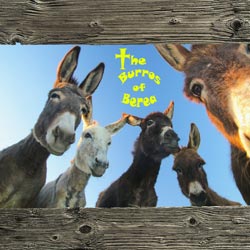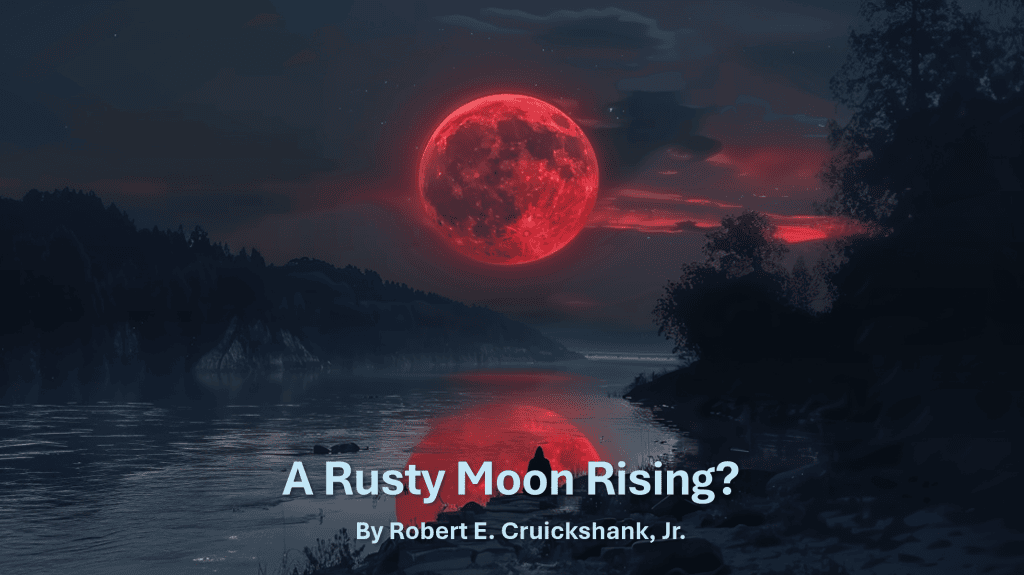There’s a Rusty Moon Rising?
Copyright © Robert E. Cruickshank, Jr. (May 16, 2024)
All Rights Reserved
Jan Logsdon (Editor)
“And I will display wonders in the sky above and signs on the earth below: Blood, fire, and vapor of smoke. The sun will be turned into darkness, and the moon into blood, before the great and glorious day of the Lord comes. And it shall be that everyone who calls on the name of the Lord will be saved” (Acts 2:19-21).
As long as mankind has been around, the moon has been “an object of our utmost fascination. As a constantly present yet ever-changing object in the sky,” writes Stefanie Waldek, “it’s no surprise that ancient cultures around the world were curious about the moon, incorporating it into all sorts of myths and legends.”[2]
This ageless fascination with the moon has made it into our own age, as well. From Doris Day’s Silvery Moon to Elvis’s Blue Moon to Pink Floyd’s Dark Side of the Moon, earth’s natural satellite has captivated our culture as surely as it has our ancestors’.
But perhaps no segment of our society has been as moonstruck as the purveyors of pop-prophecy. While they’ve written many books propagating their lunar lunacy, the best-known is John Hagee’s, Four Blood Moons: Something is About to Change. The promotional blurb for the book reads:
“In this riveting book, New York Times best-selling author, Pastor John Hagee, explores the supernatural connection of certain celestial events to biblical prophecy—and to the future of God’s chosen people and to the nations of the world. Just as in biblical times, God is controlling the sun, the moon, and the stars to send our generation a signal that something big is about to happen.”[3]
Hagee’s book came out in 2013, and it was indeed a bestseller. The problem is that it’s now 2024, and nothing “big” has happened. Well, actually, it has – sort of. As it turns out, Hagee had it all wrong. He was looking for the wrong kind of moon. It’s not really about a Blood Moon, after all. Not even a Silvery Moon or a Blue Moon. According to the latest spin on Peter’s words in Acts 2:20, there’s a rusty moon on the rise.
Supposedly, the most high-quality pictures of the moon ever taken (over 2000 images combined) clearly reveal that the moon is rusting.[4] NASA apparently confirms this, and we are told, “While the Moon is airless, research indicates the presence of hematite – a form of rust that normally requires oxygen and water, and this has scientists puzzled.”[5] Since the word “hematite” derives from the Greek word for blood (haima),[6] the prophecy pundits think that they’re onto something with regard to the moon turning into blood in Acts 2:20.
The problem with this is that haima is used 99 times in the New Testament and it always means “blood” and not “rust.” Additionally, when the Biblical writers wanted to say “rust,” they had no problem saying it:
“Do not lay up for yourselves treasures on earth, where moth and rust destroy and where thieves break in and steal” (Matt. 6:19).
They also had no problem conveying the idea of mineral corrosion:
“Your gold and silver have corroded, and their corrosion will be evidence against you and will eat your flesh like fire” (James 5:3).
Regardless of the etymology of the modern word “hematite,” reading our words back into the Scriptures is no way to do exegesis. Our goal should be to transplant ourselves into the world of Bible rather than vice versa. When we do this, the Biblical usage of cosmic-disturbance language is as unmistakable as the brightness of a full moon on a clear night.
The Language of Cosmic Disturbance in the Old Testament
The prophecies of Isaiah are a good place to start in understanding the Scriptural precedent for the language of cosmic disturbance. For example, Isaiah 24:21 says that “the Lord will punish the host of heaven on high, and the kings of the earth, on earth.” J. Richard Middleton explains how an ancient reader would have understood the prophet’s words here:
“Elsewhere in the Old Testament (as in the ancient Near East generally) it is quite clear that celestial bodies can stand for angelic or divine beings, which are either good or evil. In some texts they are YHWH’s servants, as ‘when the morning stars sang together and all the heavenly beings [lit. ‘sons of God’] shouted for joy’ (Job 38:7) at creation. Presumably, the stars in Judges 5 represent heavenly forces coming to the aid of God’s people: ‘The stars fought from heaven, from their courses they fought against Sisera’ (Judg. 5:20). This gives support to the idea that God’s punishment of ‘the host of heaven’ in Isaiah 24:21 (in parallel to kings on the earth) is a reference to judgment on false gods.”[7]
Echoing this Old Testament imagery, Jesus says that “the stars will fall from the sky, and the powers of the heavens will be shaken” (Matt. 24:29). Similarly, in the book of Revelation, John sees the stars of the sky falling to the earth as unripe figs shaken by the wind (Rev. 6:13). In this passage, John is recycling more of Isaiah’s stock vocabulary for the judgment of the false gods in the unseen realm:
“All the host of heaven shall rot away, and the skies roll up like a scroll. All their host shall fall, as leaves fall from the vine, like leaves falling from the fig tree” (Isaiah 34:4).
In context, Isaiah is talking about the time when the sword of the Lord would “descend in judgment upon Edom” (Isa. 34:5),[8] which occurred in the fifth century BC.[9] Obviously, the sky didn’t literally roll up like a scroll because it’s still spread out over top of us. Isaiah’s cosmic language indicates that the judgment would not only be upon the people of Edom, but upon Edom’s gods as well. This is similar to the Exodus, where God’s judgment came upon “both man and beast and against all the gods of Egypt” (Exod. 12:12).
The Language of Cosmic Disturbance in the New Testament
If this is how the language was used in the Old Testament, this is how it should be understood in the New Testament as well. Tying Isaiah 34:4 in with Revelation 6:13, Micheal Heiser puts it together for us:
“…because he’s drawing specifically on Isaiah 34:4, when you go to Revelation 6:13-14, he talks about the stars of heaven falling, he’s not talking about an asteroid catastrophe. We’re not talking about something NASA can defeat. Dispense with the uber-literalism. We’re talking about the judgment of cosmic powers of darkness along with suffering and apocalyptic violence on the earth. These two things go together, folks. This is the Deuteronomy 32 worldview. This is the Daniel 10 worldview. The powers on earth… Behind them are other supernatural powers that are using them, manipulating them, steering things to the ends to that they want. If in Revelation we’re describing the judgment of human powers that are persecuting believers, you would think—you would think—that John wouldn’t leave out the judgment of the fallen gods of the Old Testament—the corrupt sons of God (Psalm 82), the princes of the nations (Daniel 10).”[10]
James Jordan concurs, writing: “In this way, the astral symbols are given peculiar coloring depending on context. The Babylonians worshiped the stars, and so they are extinguished. The Egyptians worshiped the sun, so God darkens it.”[11] The stars weren’t literally extinguished, and the sun wasn’t literally darkened, but God literally judged those nations and their gods.
Circling back to Peter’s use of Joel 2:31 and the moon turning to blood (Acts 2:20), the audience on that day included “Jews and proselytes” from all over the Roman Empire – including Mesopotamia (Acts 2:10). Just as the Egyptians (who were also there on that day) worshiped the sun, the Mesopotamians worshiped the moon. Peter’s message was that Jesus had been “exalted to the right hand of God” (Acts 2:33), and it was lights out for the gods of the other nations.
As these new believers returned home after the Day of Pentecost, the Gospel would penetrate and permeate the nations from which they came. And they would bring Peter’s message with them – the territorial deities, who formerly had dominion over them, were being displaced, disarmed, and defeated (cf. Col. 2:15). The stars fall, the sun is darkened, and the moon turns to blood, as the Morning Star arises in the hearts of Jesus’s followers (2 Pt. 1:19).
Once again, the pop-prophecy pundits have it wrong and Joel 2:31 and Acts 2:20 aren’t about a rusty moon or even a literal blood moon. And we don’t need 2000 images of the moon to piece together what is going on in the Biblical text. All we need is a little knowledge of how the same language is used elsewhere in Scripture. It’s been said that crazy things happen when there’s a full moon. Likewise, crazy interpretations happen without a full understanding of Scriptural metaphors. The moon is fascinating. The Bible’s use of the moon as a symbol is fascinating. The lack of understanding of how the symbol is used, however, leads to nothing but mindless fascination.[12]
______________________________________________________________
[2] https://www.space.com/moon-fascination-culture-history
[3] https://www.jhm.org/products/b194p-four-blood-moons#:~:text=In%20this%20riveting%20book%2C%20Pastor,the%20nations%20of%20the%20world.
[4] https://www.youtube.com/watch?v=CDAp2tdRG38 – a shout out to my good friend, Brett Prieto, for sending me this video. Check out his YouTube Channel, Warrior Chamber Studios, here: https://www.youtube.com/@warriorchamberstudios4000
[5] Ibid.
[6] https://www.britannica.com/science/hematite
[7] J. Richard Middleton, A New Heaven and a New Earth: Reclaiming Biblical Eschatology (Grand Rapids, MI: Baker Academic, 2014), p. 117.
[8] See: David Chilton, Paradise Restored (Tyler, TX: Dominion Press, 1985), p. 99.
[9] https://www.gotquestions.org/prophecies-against-Edom.html
[10] https://nakedbiblepodcast.com/wp-content/uploads/2021/04/NB-370-Transcript.pdf, pp. 16-17
[11] James B. Jordan, MATTHEW 23-25: A LITERARY, HISTORICAL, AND THEOLOGICAL COMMENTARY (Powder Springs, GA: American Vision, 2022), p. 174.
[12] Thanks to Daniel E. Harden, Don K. Preston, Eric Ogea, and Brett Prieto for their feedback and input on the early draft of this article.

